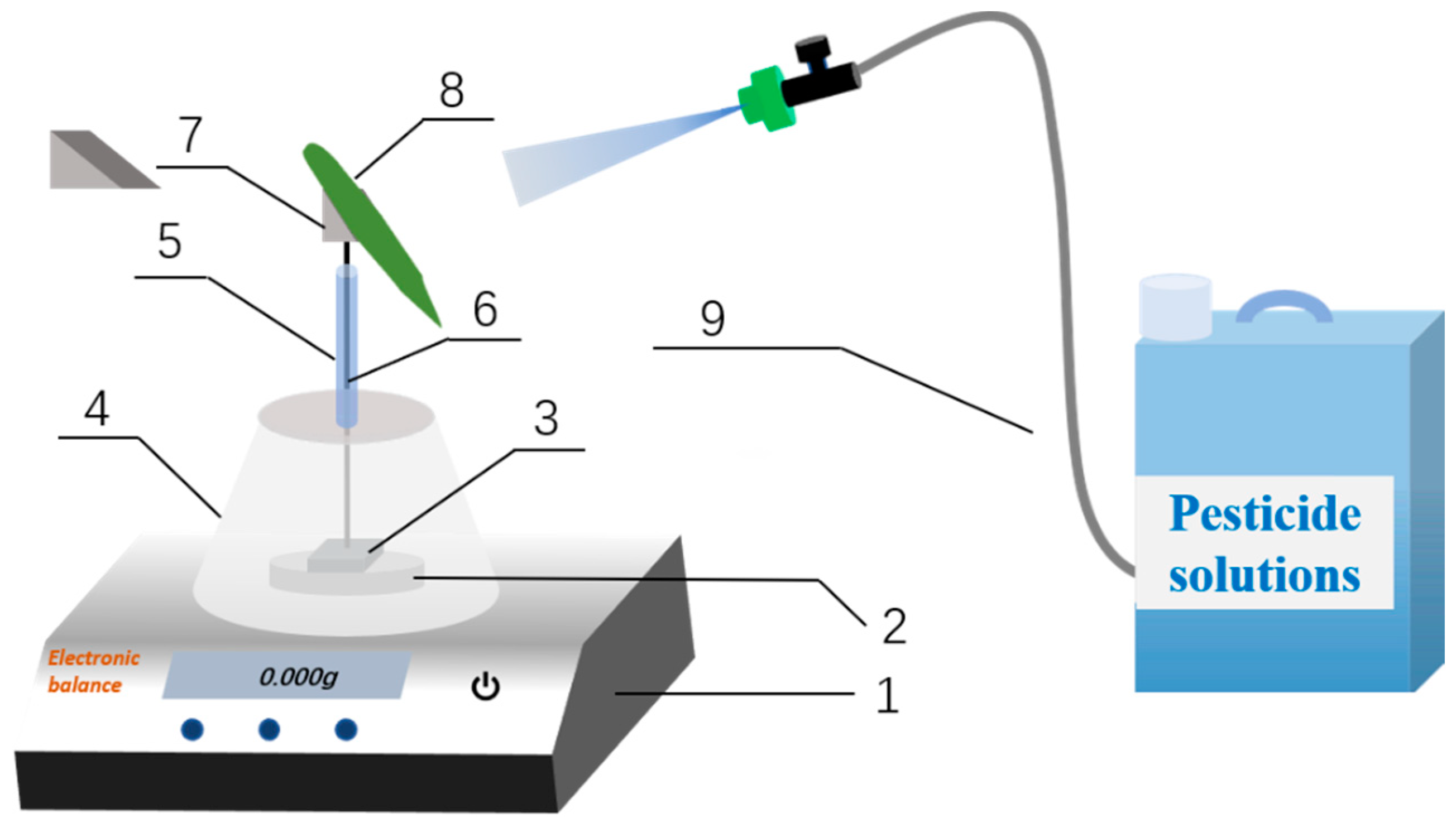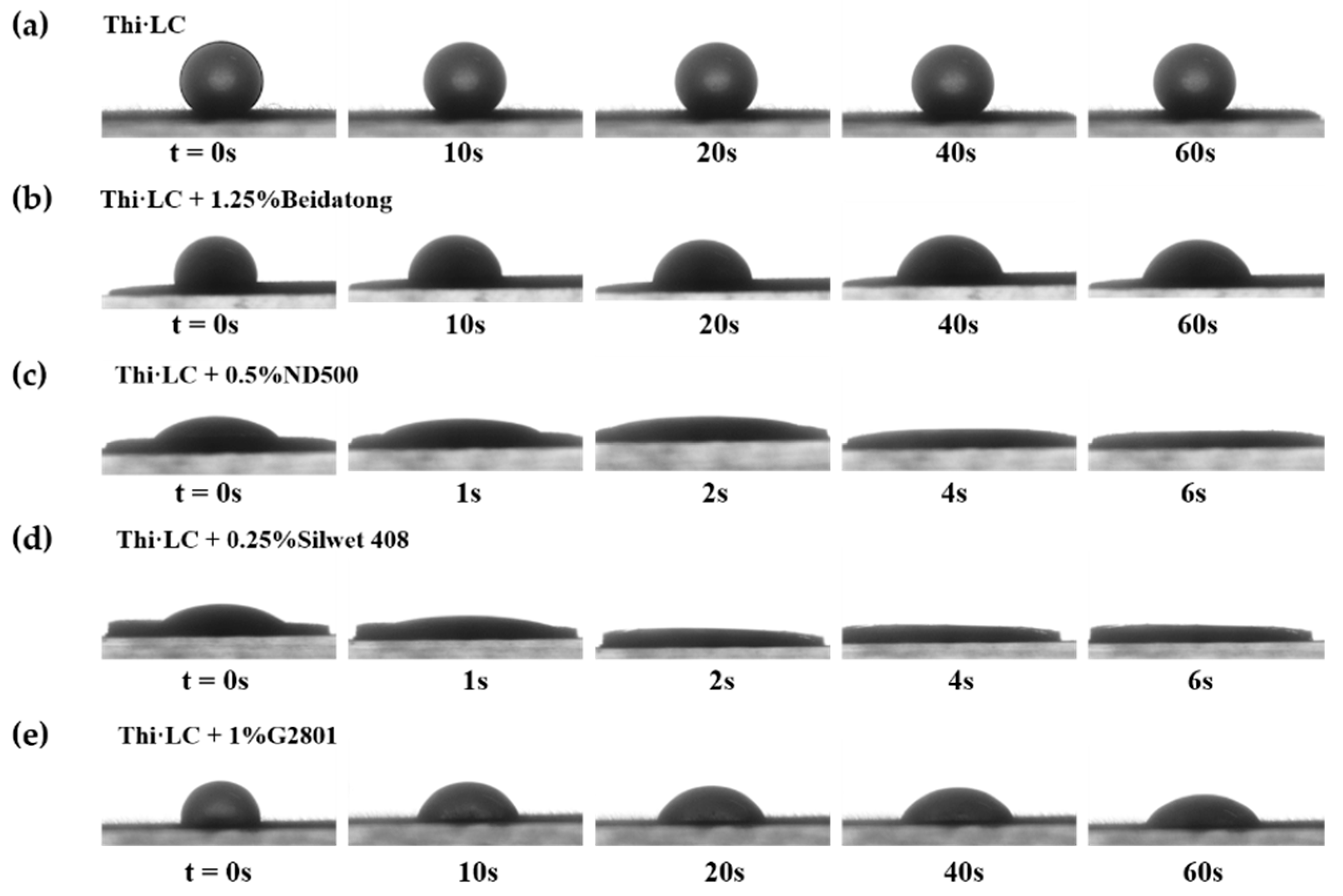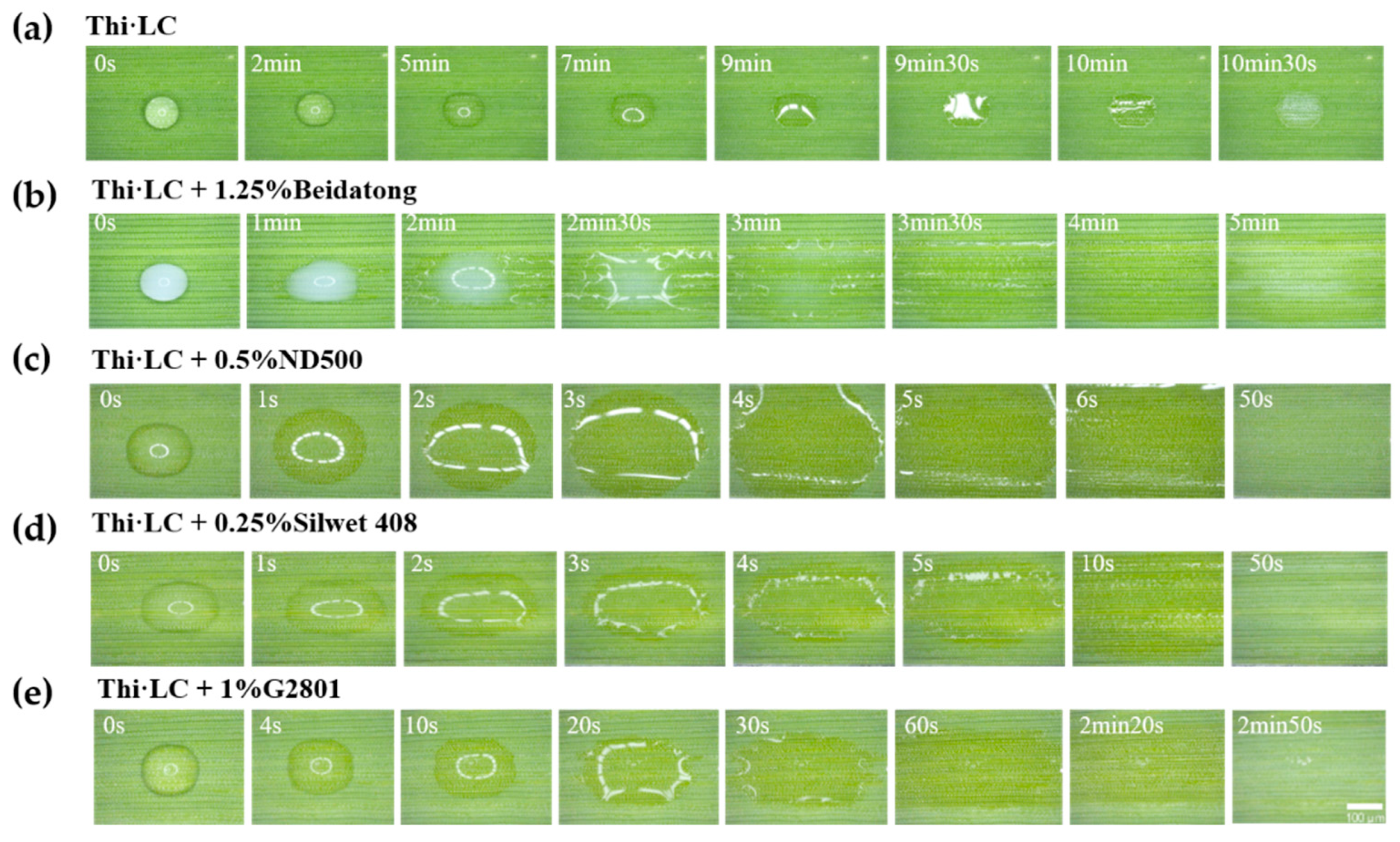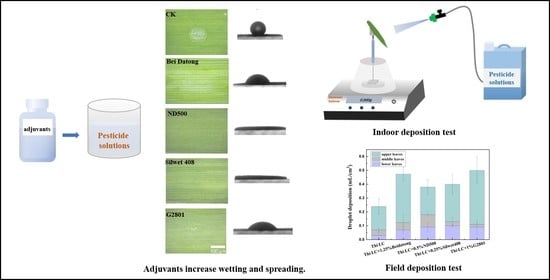The Effects of Adjuvants on the Wetting and Deposition of Insecticide Solutions on Hydrophobic Wheat Leaves
Abstract
:1. Introduction
2. Materials and Methods
2.1. Materials
2.2. Determination of Surface Tension
2.3. Wetting and Spreading Performance of Droplets on Wheat Leaves
2.4. Determination of the Point of Run-Off and Maximum Retention of Leaves
2.5. Field Experiment
2.6. Data Analysis
3. Results and Discussion
3.1. Determination of CMC Concentration of Adjuvants
3.2. Wetting and Spreading of Pesticide Droplets on Wheat Leaves
3.3. Effects of Spray Adjuvants on Pesticide Droplets Deposition
3.4. Field Experiment
4. Conclusions
Author Contributions
Funding
Institutional Review Board Statement
Informed Consent Statement
Data Availability Statement
Conflicts of Interest
References
- Larsen, A.; Powers, L.; McComb, S. Identifying and characterizing pesticide use on 9000 fields of organic agriculture. Nat. Commun. 2021, 12, 5461. [Google Scholar] [CrossRef] [PubMed]
- Song, M.; Ju, J.; Luo, S.; Han, Y.; Dong, Z.; Wang, Y.; Gu, Z.; Zhang, L.; Hao, R.; Jiang, L. Controlling liquid splash on superhydrophobic surfaces by a vesicle surfactant. Sci. Adv. 2017, 3, e1602188. [Google Scholar] [CrossRef] [PubMed]
- Liu, B.; Fan, Y.; Li, H.; Zhao, W.; Luo, S.; Wang, H.; Guan, B.; Li, Q.; Yue, J.; Dong, Z.; et al. Control the entire journey of pesticide application on superhydrophobic plant surface by dynamic covalent trimeric surfactant coacervation. Adv. Funct. Mater. 2020, 31, 2006606. [Google Scholar] [CrossRef]
- Schulzt, R.; Bub, S.; Petschick, L.; Stehle, S.; Wolfram, J. Applied pesticide toxicity shifts toward plants and invertebrates, even in GM crops. Science 2021, 372, 81–84. [Google Scholar] [CrossRef]
- Horak, I.; Horn, S.; Pieters, R. Agrochemicals in freshwater systems and their potential as endocrine disrupting chemicals: A South African context. Environ. Pollut. 2021, 268, 115718. [Google Scholar] [CrossRef] [PubMed]
- Zhang, X.; Xiong, L. Effect of adjuvants on the spray droplet size of pesticide dilute emulsion. Colloid Surf. A-Physicochem. Eng. Asp. 2021, 619, 126557. [Google Scholar] [CrossRef]
- Lan, Y.; Shan, C.; Wang, Q.; Liu, Q.; Yang, C.; Xie, Y.; Wang, G. Effects of different spray additives on droplet deposition characteristics during plant protection UAV spraying operations. Trans. CSAE 2021, 37, 31–37. [Google Scholar] [CrossRef]
- Tredenick, E.; Forster, W.; Pethiyagoda, R.; Leeuwen, R.; McCue, S. Evaporating droplets on inclined plant leaves and synthetic surfaces: Experiments and mathematical models. J. Colloid Interface Sci. 2021, 592, 329–341. [Google Scholar] [CrossRef]
- Katzman, D.; Bohbot-Raviv, Y.; Dubowski, Y. Does polyacrylamide-based adjuvant actually reduce primary drift of airborne pesticides? Sci. Total Environ. 2021, 775, 145816. [Google Scholar] [CrossRef]
- Xiao, Q.; Fang, X.; Lou, Z.; Zhou, T.; Wang, G.; Han, X.; Lan, Y.; Fu, W. Effect of aviation spray adjuvants on defoliant droplet deposition and cotton defoliation efficacy sprayed by Unmanned Aerial Vehicles. Agronomy 2019, 9, 217. [Google Scholar] [CrossRef] [Green Version]
- Li, X.; He, L.; Pang, X.; Gao, Y.; Liu, Y.; Zhang, P.; Wei, G.; Mu, W.; Li, B.; Liu, F. Tank-mixing adjuvants enhanced the efficacy of fludioxonil on cucumber anthracnose by ameliorating the penetration ability of active ingredients on target interface. Colloid Surf. B-Biointerfaces 2021, 204, 111804. [Google Scholar] [CrossRef] [PubMed]
- Gao, Y.; Li, X.; He, L.; Li, B.; Mu, W.; Liu, F. Role of adjuvants in the management of anthracnose-change in the crystal morphology and wetting properties of fungicides. J. Agric. Food Chem. 2019, 67, 9232–9240. [Google Scholar] [CrossRef] [PubMed]
- Zhao, R.; Sun, Z.; Bird, N.; Gu, Y.; Xu, Y.; Zhang, Z.; Wu, X. Effects of tank-mix adjuvants on physicochemical properties and dosage delivery at low dilution ratios for unmanned aerial vehicles application in paddy field. Pest Manag. Sci. 2022, 78, 1582–1593. [Google Scholar] [CrossRef] [PubMed]
- He, L.; Ding, L.; Li, B.; Mu, W.; Li, P.; Liu, F. Regulating droplet wetting and pinning behaviors on pathogen-modifiedhydrophobic surfaces: Strategies and working mechanisms. J. Agric. Food Chem. 2021, 69, 11720–11732. [Google Scholar] [CrossRef]
- Stock, D.; Geoff, B. Physicochemical properties of adjuvants: Values and applications1. Weed Technol. 2000, 14, 798–806. [Google Scholar] [CrossRef]
- Knoche, M. Organosilicone surfactant performance in agricultural spray application: A review. Weed Res. 1994, 34, 221–239. [Google Scholar] [CrossRef]
- Stevens, P. Organosilicone surfactants as adjuvants for agrochemicals. Pestic. Sci. 1993, 38, 103–122. [Google Scholar] [CrossRef]
- Gaskin, R.; Murray, R.; Krishna, H.; Carpenter, A. Effect of adjuvants on the retention of insecticide spray on cucumber and pea foliage. N. Z. Plant Prot. 2000, 53, 355–359. [Google Scholar] [CrossRef]
- He, L.; Ding, L.; Zhang, P.; Li, B.; Mu, W.; Liu, F. Impact of the equilibrium relationship between deposition and wettability behavior on the high-efficiency utilization of pesticides. Pest Manag. Sci. 2021, 77, 2485–2493. [Google Scholar] [CrossRef]
- Yuan, H.; Qi, S.; Yang, D. Study on the point of run-off and the maximum retention of spray liquid on crop leaves. Chin. J. Pestic. Sci. 2000, 2, 66–71. [Google Scholar] [CrossRef]
- Wirth, W.; Storp, S.; Jacobsen, W. Mechanisms controlling leaf retention of agricultural spray solutions. Pestic. Sci. 1991, 33, 411420. [Google Scholar] [CrossRef]
- Zhao, X.; Gao, Y.; Zhang, C.; Zhu, Y.; Lei, J.; Ma, Y.; Du, F. Wettability of ionic surfactants SDS and DTAB on wheat (Triticum aestivum) leaf surfaces. J. Dispers. Sci. Technol. 2018, 39, 1820–1828. [Google Scholar] [CrossRef]
- He, L.; Xi, S.; Ding, L.; Li, B.; Mu, W.; Li, P.; Liu, F. Regulating the entire journey of pesticide application on surfaces of hydrophobic leaves modified by pathogens at different growth stages. ACS Nano 2021, 16, 1318–1331. [Google Scholar] [CrossRef] [PubMed]
- Zhou, Z.; Cao, C.; Cao, L.; Zheng, L.; Xu, J.; Li, F.; Huang, Q. Effect of surfactant concentration on the evaporation of droplets on cotton (Gossypium hirsutum L.) leaves. Colloid Surf. B-Biointerfaces 2018, 167, 206–212. [Google Scholar] [CrossRef]
- Gao, X.; Li, M.; Li, J.; Feng, F. Effect of different spray factors on weed control in wheat field by unmanned aerial vehicle. Chin. J. Pestic. Sci. 2020, 22, 340–346. [Google Scholar] [CrossRef]
- Arand, K.; Asmus, E.; Popp, C.; Schneider, D.; Riederer, M. The mode of action of adjuvants-relevance of physicochemical properties for effects on the foliar application, cuticular permeability, and greenhouse performance of pinoxaden. J. Agric. Food Chem. 2018, 66, 5770–5777. [Google Scholar] [CrossRef] [PubMed]
- Liu, S.; Dutcher, C. Measurements of static and dynamic bubble surface tension using a deformation-based microfluidic tensiometer. J. Phys. Chem. B. 2021, 125, 13916–13927. [Google Scholar] [CrossRef] [PubMed]
- Rosalind, D.; Buchan, G.; Field, R. The role of surface tension of spreading droplets in absorption of a herbicide. Pestic. Sci. 1993, 38, 227–235. [Google Scholar] [CrossRef]
- He, L.; Ding, L.; Li, B.; Mu, W.; Li, P.; Liu, F. Optimization strategy to inhibit droplets rebound on pathogen-modified hydrophobic surfaces. ACS Appl. Mater. Interfaces 2021, 13, 38018–38028. [Google Scholar] [CrossRef]
- Policello, G.; Murphy, G. The influence of co-surfactants on the spreading ability of organosilicone wetting. Pestic. Sci. 1993, 37, 228–230. [Google Scholar] [CrossRef]
- Zheng, L.; Cao, C.; Chen, Z.; Cao, L.; Huang, Q.; Song, B. Efficient pesticide formulation and regulation mechanism for improving the deposition of droplets on the leaves of rice (Oryza sativa L.). Pest Manag. Sci. 2021, 77, 3198–3207. [Google Scholar] [CrossRef] [PubMed]
- Song, Y.; Huang, G.; Zheng, L.; Huang, Q.; Cao, L.; Li, F.; Zhao, P.; Zhang, L.; Cao, C. Polymer additives regulate the deposition behavior of pesticide droplets on target plants. Polym. Test 2021, 93, 106958. [Google Scholar] [CrossRef]
- Wang, C.; Herbst, A.; Zeng, A.; Wongsuk, S.; Qiao, B.; Qi, P.; Bonds, J.; Overbeck, V.; Yang, Y.; Gao, W.; et al. Assessment of spray deposition, drift and mass balance from unmanned aerial vehicle sprayer using an artificial vineyard. Sci. Total Environ. 2021, 777, 146181. [Google Scholar] [CrossRef] [PubMed]
- Wang, Z.; Zheng, C.; Li, T.; He, X. Analysing the preference for pesticide spray to be deposited at leaf-tips. Biosyst. Eng. 2021, 204, 247–256. [Google Scholar] [CrossRef]
- Song, M.; Duan, H.; Zheng, X.; Wang, L.; Yu, Z.; An, W.; Na, R.; Li, C.; Li, N.; Lu, Z.; et al. Enhancing droplet deposition on wired and curved superhydrophobic leaves. ACS Nano 2019, 13, 7966–7974. [Google Scholar] [CrossRef]








Publisher’s Note: MDPI stays neutral with regard to jurisdictional claims in published maps and institutional affiliations. |
© 2022 by the authors. Licensee MDPI, Basel, Switzerland. This article is an open access article distributed under the terms and conditions of the Creative Commons Attribution (CC BY) license (https://creativecommons.org/licenses/by/4.0/).
Share and Cite
Song, Y.; Huang, Q.; Huang, G.; Liu, M.; Cao, L.; Li, F.; Zhao, P.; Cao, C. The Effects of Adjuvants on the Wetting and Deposition of Insecticide Solutions on Hydrophobic Wheat Leaves. Agronomy 2022, 12, 2148. https://doi.org/10.3390/agronomy12092148
Song Y, Huang Q, Huang G, Liu M, Cao L, Li F, Zhao P, Cao C. The Effects of Adjuvants on the Wetting and Deposition of Insecticide Solutions on Hydrophobic Wheat Leaves. Agronomy. 2022; 12(9):2148. https://doi.org/10.3390/agronomy12092148
Chicago/Turabian StyleSong, Yuying, Qiliang Huang, Guizhen Huang, Mingxin Liu, Lidong Cao, Fengmin Li, Pengyue Zhao, and Chong Cao. 2022. "The Effects of Adjuvants on the Wetting and Deposition of Insecticide Solutions on Hydrophobic Wheat Leaves" Agronomy 12, no. 9: 2148. https://doi.org/10.3390/agronomy12092148
APA StyleSong, Y., Huang, Q., Huang, G., Liu, M., Cao, L., Li, F., Zhao, P., & Cao, C. (2022). The Effects of Adjuvants on the Wetting and Deposition of Insecticide Solutions on Hydrophobic Wheat Leaves. Agronomy, 12(9), 2148. https://doi.org/10.3390/agronomy12092148








